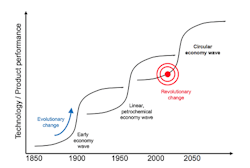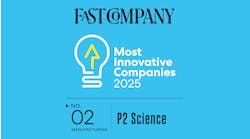Sustainability: The Future Is Circular
One word summed up the career advice offered in the classic 1967 movie “The Graduate.” A neighbor, Mr. McGuire (played by Walter Brooke), took Benjamin Braddock (Dustin Hoffman) aside and simply said: “plastics.” McGuire had it right. Plastics were phenomenally successful. Their versatility and low cost underpinned many convenient new products and components that impacted every aspect of modern life. In fact, 1967 might well mark the high point of the public’s enchantment with the chemical industry. The luster tarnished during the 1970s and 1980s as greater awareness of the industry’s environmental problems emerged (see, e.g., “Earth Day is Golden”).
That high point tracks very well the second of the two significant waves of innovation and development experienced by the chemical industry (Figure 1). The initial wave, which dates back to the mid-1800s, saw the emergence of the first “chemical” products such as paints and soaps derived from natural materials like oils and fats. The second wave, which began in the early part of the 20th century, exploited abundant fossil feedstocks like coal and oil to create a plethora of new products, including plastics.
However, the innovative boom of the petrochemical wave largely had run its course by the 1990s. The last 25 years mostly have seen incremental improvements. This coincided with society becoming increasingly concerned about the use of fossil fuel resources, the related carbon dioxide (CO2) emissions, and the disposal of waste, including plastics. In fact, despite their clear sustainability benefits, plastics now symbolize all that’s problematic about our “take-make-waste” economy: taking resources from the earth, making products that are used once or just a few times, and then discarding them as waste. The waste either winds up in a landfill, decomposes or goes to an incinerator, causing CO2 emissions. Often, the waste isn’t managed at all; the plastics in our oceans are but one very visible aspect of just that. In short, this linear nature of our business practices is the prime concern.
The Third Technology Wave
The first wave of chemical industry development was overtaken by the second one — slowly at first, then rapidly. Similarly, while the petrochemical wave has been flatlining, a third wave of innovation — that of circular chemistry — has started to emerge. Circular chemistry moves away from take-make-waste. It involves circular business models that don’t extract fossil raw materials and that avoid wastes. These focus on three approaches: turning waste into new materials; using renewable nature-derived crops to make products; and applying renewable energy to manufacture products.
1. Waste material recycling. A primary strategy to change our current linear model is to use the waste that we produce as a raw material. This certainly isn’t new. We’ve been recycling aluminum and batteries for quite a while and increasingly are retrieving valuable raw materials from electronic waste.
There’s no doubt that as we move into the circular economy we will have to recycle more and more materials. A prime focus should be the enormous amounts of waste that we create, much of it municipal solid waste (MSW). Unfortunately, MSW isn’t an easy material to work with. Unlike oil and gas, it is heterogeneous, containing components as different as plastics and peels. It also is variable. Even waste from one location will change in composition and humidity by season, sometimes even within one week. Using waste may require extensive sorting — by citizens or in waste sorting centers. Alternatively, you need technology that can deal with the variability. This is what my own company Enerkem, Montréal, (www.enerkem.com) has developed. It has spent 25 years perfecting a technology for gasification of household waste with as little pre-treatment as possible. The process turns the waste into a mixture of carbon monoxide (CO) and hydrogen (H2), also known as syngas. Syngas is a great building block for chemicals and fuels. It traditionally was made from coal; even today, companies like Sasol use coal to make their products. In contrast, Enerkem syngas consists entirely of molecules that previously would have been landfilled or incinerated — it’s “recycled carbon.” This circular syngas can replace the oil and gas that the chemical industry currently relies upon. It can serve as feedstock for myriad products the chemical industry makes today. By using waste as a feedstock, the chemical industry tackles two important issues: fouling of the environment and dependence on fossil materials.
Figure 1. The chemical industry is facing challenges that will promote a circular economy.
2. Substitution by bio-feedstocks. A second circular strategy uses bio-derived renewable feedstocks like sugar and agricultural biomass to replace current fossil feedstocks. Biomass is circular by definition. Plants and microorganisms take CO2 out of the atmosphere and build biomass when they use the energy of the sun to convert it into materials like wood, sugars or vegetable fats. The chemical industry can convert these materials into the products that we use in everyday life. Moreover, doing so eliminates the problems posed by some materials such as agricultural wastes, which now are discarded or burned and add to CO2 emissions.
Bio-based materials can be drop-in substitutes — exactly equivalent molecularly to the fossil material they are replacing — or functional equivalents — having a different molecular structure but performing the same or similarly.
Solugen, Houston, (www.solugentech.com ) provides an example of the first type. This startup has identified and optimized naturally occurring enzymes that can turn sugar into hydrogen peroxide, a chemical commonly used in the production of paper products. This hydrogen peroxide is identical to that produced conventionally. However, Solugen hydrogen peroxide is biogenic and circular, derived from only natural raw materials, while current hydrogen peroxide is fossil-derived and, thus, leads to CO2 emissions.
An example of functional equivalence comes from startup Holiferm, Manchester, U.K., (www.holiferm.com). It has developed fermentation technology to make so-called sophorolipids, natural cleaning agents produced by bacteria. They not only are excellent cleaning agents but also are non-toxic and biodegradable when they end up in the environment. Sophorolipids can replace traditional cleaning agents in many applications, avoiding fossil raw materials and emission of fossil CO2 and hazardous substances. As the chemical industry moves away from linear fossil products, it increasingly will seek bio-feedstock substitutes to deliver the same benefits that customers are used to — but at lower impact for people and the planet.
3. Reliance on renewable power: The final circular strategy uses renewable electricity from wind and sun to make materials. We are in the early phases of this development but its most-talked-about example is hydrogen — particularly production via electrolysis of water (see, e.g., “Hydrogen Gives Electrolysis a Lift,” https://bit.ly/30vPA1B). When the electricity for the water splitting is produced from coal or gas, the resultant hydrogen still is fossil-based. The game-changer is the development of low-cost renewable power that, over time, will give the chemical industry a cheap source of electricity. This will enable production of hydrogen without emission of CO2. This hydrogen can serve as a feedstock for chemical making and as a transportation fuel. The holy grail is to convert CO2, extracted at sites that emit lots of CO2 such as power plants, and react it with hydrogen. This makes chemicals in a process comparable to how Enerkem turns syngas from waste into chemicals. While profitable commercial exploitation still is a long way off, we surely will see exciting developments in this field in the next 10–20 years.
Inflection Point And Challenges
Solving the plastic waste crisis, moving away from oil and gas, stopping emissions of CO2 and hazardous substances — in short, moving to a circular economy — will pose a challenge of massive proportions. It will take society at least a generation, maybe two. The pervasive role of chemicals in our lives means the chemical industry must make a vital contribution to this transition. For every linear take-make-waste solution existing today, the industry must develop an alternative that uses bio-based or circular raw materials or renewable energy. It also must devise a circular business approach to deal with all the waste caused by its products. Tackling the plastics in our household waste is only the beginning.
Can we even do this? Based on experience, there should be no doubt. Just looking back at how the second wave of chemical innovation transformed the world in little over 50 years should give us confidence. As a society, we have the ingenuity, creativity and resolve to come up with products and solutions to vastly improve human existence. The sheer number of circular developments and startups shows that we have come to an inflection point of circular chemistry: the moment that a trickle becomes a stream and when industry participants accept that, this new technology wave will break through.
That said, there will be challenges. First and foremost, circular approaches generally are more expensive than the take-make-waste approach that we’ve followed so far. Fossil raw materials were made by planet earth “for free” and disposing of our waste and CO2 has incurred limited cost. To make circular approaches competitive, governments can facilitate and stimulate industry and its customers. For example, government can mandate that all plastics contain a certain, increasing amount of recycled material. Or it can regulate the maximum amount of fossil-derived ingredients allowable in common cleaners, stimulating producers to find bio-derived alternatives. Last but not least, government can set a price on emissions, such as is being proposed for those of CO2. Such edicts will compel producers to innovate, looking for new solutions to comply with these measures in the cheapest possible way. This will generate new jobs and wealth.
A second challenge is the availability of capital to finance the startup and scaleup of circular approaches. This is particularly important at times of radical change, when existing companies may be stuck in old ways. New startup companies provide essential innovation dynamism and speed to make the transition to the new technology wave. Although more capital is needed, we are seeing an increasing availability of funding for the circular transition. For example, the European Commission and the European Investment Bank recently announced the European Circular Bio-economy Fund (www.ecbf.vc). Ultimately with €250 million to invest, it will provide funding for late-stage startups, closely aligned with the European Green Deal (https://bit.ly/33vsqKM).
A Word To The Wise
As the cliché goes, the stone age didn’t end because we ran out of stones. We just moved on to something better. Equally, the petroleum age won’t end because we will run out of crude oil. It will end because we will move on to a better way of making products — one that doesn’t rely on extracting fossil materials and turning them into waste and CO2 emissions. Rather, we increasingly will employ circular processes, using waste, biomass and renewable energy. The chemical industry will play a vital role harnessing these technologies to supply the ingredients, components and materials needed to produce all those essential convenient everyday products that make up modern life. Are you looking for a promising new business for the coming decades? Focus on one word: circular.
PETER J. NIEUWENHUIZEN is Amersfoort, The Netherlands-based, vice president, technology strategy & deployment, for Enerkem. Email him at [email protected].



